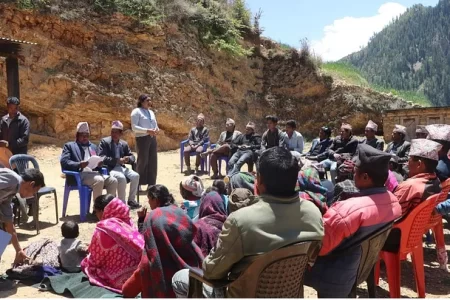With Nepal’s transition from a unitary government system to a federal system in 2017, there has been a significant transfer of executive powers to the local governments. This shift has meant numerous opportunities for the LGs to independently formulate and implement laws, policies, annual plans, and budgets in line with the constitutional mandates. The constitutional and legal provisions require elected representatives to pay special attention to the interests and needs of the marginalized groups, such as women, Dalits, and historically disadvantaged people within the community.
Despite these opportunities, many elected representatives, and citizens have limited knowledge about their roles and responsibilities within the local governing system. To bridge this gap, the Government of Nepal’s (GoN) flagship programme, Provincial and Local Governance Support Programme (PLGSP), has been implementing capacity-building trainings on various thematic areas with an aim to strengthen the processes. While these initiatives have had helped address the capacity gap in the local governments, the demand for learning and capacity-building initiatives remains high.
Although a number of institutions have supported local governments in strengthening their processes and systems, the implementation on the ground has been very effective. This is more evident in Karnali Province which sits at the bottom of several development indicators. Its geographical remoteness is further highlighted by a severe lack of physical connectivity. Karnali is the most challenging province in terms of accessibility. The knowledge of the elected representatives as well as the electorate is on the local-level planning process and the ins and outs of the governance system is limited. Even the representative who are experienced and more knowledgeable struggle to implement the processes effectively. As a result, there is only minimal progress over the years in terms of institutionalizing the processes and systems, raising questions about the accountability of the elected offices to the constituents.
To address the gaps in the planning process and knowledge of elected representatives, simulation modeling was introduced as a tool in three local governments– Soru and Tila Rural Municipalities and Dullu Municipality — in Karnali Province during the orientation sessions on annual planning and budgeting.
The effectiveness of simulation modeling was tested in five local governments that have been designated by the provincial government as ‘Model Palikas’ where the European Union Support to Inclusive Federalism (EUSIF), a Karnali-based UNDP project complementing the PLGSP, is providing technical support in strengthening the systems and procedures. The modeling process followed a step-by-step procedure with the participation of ward chairpersons, ward committee members, administrative staff, community organizations such as Tole Bikas Sanastha, women and youth groups and the community people including Dalits, women and members of marginalized groups. The objective of the simulation exercise was to reflect on the existing practices and adopt a more participatory and need-driven processes envisioned by the Local Government Operations Act (LGOA). In all wards where the simulation was conducted, an encouraging number of community members including women and youth participated with keen interest. Many of them including the elected ward representatives had attended this kind of exercise for the first time and described it as a great learning opportunity and committed to translate the knowledge into the actual planning process of the local government.
“Participation of community people in the planning process is essential. We also understood the real issues of people after participating in the simulation and settlement-level plan selection exercises. We will prioritize the plans that came directly from the communities.”
– Gorikala Budha, Vice Chairperson, Tila Rural Municipality.
“Budget used to be allocated on pro rata basis without a proper needs assessment. I now understand that budget allocation should consider indicators such as population, poverty index, human development index, and social inclusion. The knowledge I gained during the simulation exercise helps me and others to voice our concerns during the planning and decision-making process of the local government”
— Rajkina Sarki, a Dalit executive member from Ward No 4, Tila Rural Municipality
Simulation modeling enables participants to understand the concerns and specific needs of the communities — more importantly the needs of women and other marginalized groups. It helped amplify the voices that went unheard and empower the communities by integrating their voices in the local, provincial, and federal levels plans and annual budgets. Integration of simulation modeling with classroom-based training in the three Model Palikas of Karnali Province provided the decision makers at the local level with insights into the planning process and budget allocation.
“The local-level planning simulation and settlement-level consultations provided us important insights on the policy gaps and lapses and adopt mitigation measures.”
– Buddhi Bahadur Khatri, Chief Administrative Officer of Karnali Province Planning Commission, who participated in the planning events in Soru Rural Municipality as facilitator.
To test the effectiveness of simulation modeling the three Model Palikas reached out to the communities as part of the local level planning. They aim to prioritize the development projects based on the demands of the communities for the fiscal year 2080/81. These three local governments conducted extensive settlement-level consultations in an inclusive manner. This exercise allowed them to understand the importance of the settlement-level planning process as mandated by the LGOA and systematize it according to the needs of their citizens. This approach also helped foster trust between the local governments and their constituents, making their relationship stronger.

